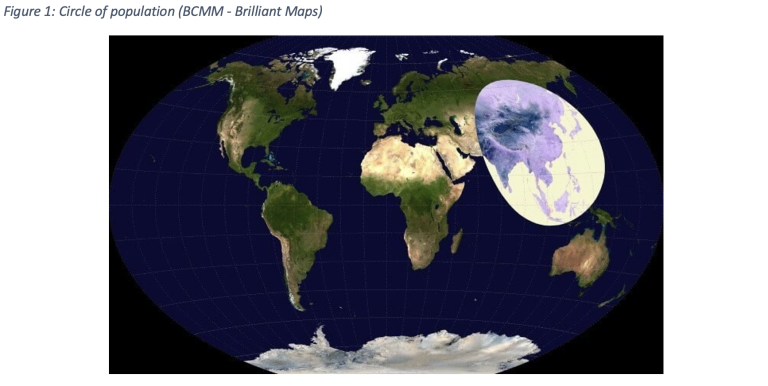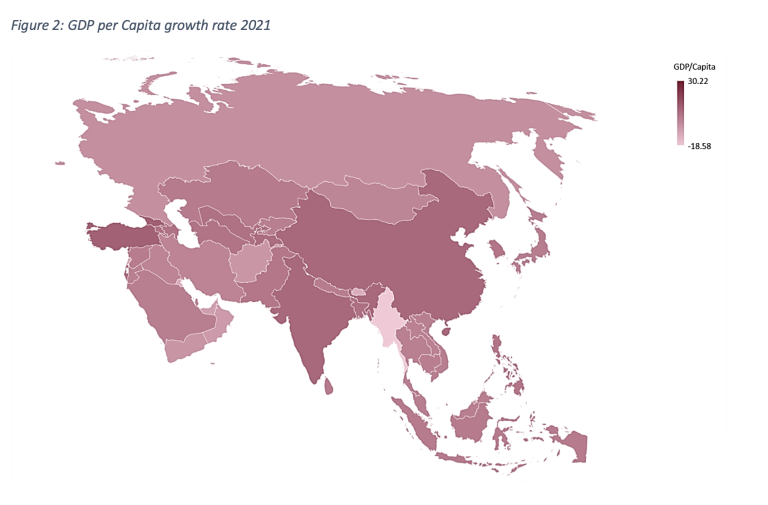“Decent Work and Economic Growth” in Asia
 Adam MacRae
Adam MacRae  September 12, 2022
September 12, 2022  Adam MacRae
Adam MacRae  September 12, 2022
September 12, 2022 Next up, we return to the most populated continent on earth: Asia. Here we examine ‘Decent Work and Economic Growth’ with a specific focus on the annual growth rate of Gross Domestic Product (GDP) per capita in the region. Defined by the United Nations, the target aims for a rate of 7% GDP growth in the least developed countries through 2030.
To highlight the significance of economic growth in Asia, we turn our attention to Figure 1 below. In the highlighted circle there are more people living within it than in the rest of the world combined. What is even more striking is this area does not even include the rest of the countries included within Asia, home to 6 of the 10 most populous countries.

A country can expect its economy to double every 30 years if its economy grows at 3% a year – for GDP per capita, this is assuming it is matching population growth. As mentioned above, the least developed countries are aiming to grow at 7% per year, meaning their economies would double in 15 years in line with the target year of 2030.
Unfortunately, from 2015-2021, the region has averaged a rate of 1.2% of annual GDP growth per capita. As illustrated in Figure 2, this average hides a wide variety of growth rates. For example, Myanmar’s economy contracted by 18.58% in 2021 because of the disastrous military junta that led to a civil war. Other countries like Turkey grew at 10.78%, but that is because the President threw conventional economic caution to the wind and is attempting to battle inflation by lowering interest rates to keep the economy growing at a steady rate.
Ultimately, in order for Asia to have any hope of achieving its economic aims, it will require a combination of political stability as well as enormous investments in education, infrastructure, and agricultural productivity. Given the already large size of Asia and its growing population, supporting this would be monumental and require 600 million new jobs to be created just to match the growth of the working age population.
Another critical factor is not just by how much Asia’s economy grows, but if it can do so sustainably. According to estimates by Bain & Co. (a consultancy) if Southeast Asia (not including the rest of Asia) were to develop a green economy, it could provide nearly $1 trillion in annual economic opportunities by 2030.
The history of economic growth – and GDP per capita – can be divided into two phases: slow, and fast. The first phase covers most of human history, characterized by a time where people’s lives and routines were more predictable. For example, in England, the average GDP per capita from 1270 through 1650 remained relatively constant at around C.£1,000 in today’s prices.
Once the Industrial Revolution began humanity entered the second phase. Since the late 1700s, incomes in the UK have risen 29x. This is a trend that has been experienced around the world from South Korea to Sri Lanka and has brought untold benefits to billions of people. As a result of these gains and sustained growth, Asia has once again become the world’s largest regional economy.
Before the pandemic, the region was making great strides with most low-income countries making significant progress towards ending extreme poverty and providing the necessary infrastructure to support their populations. However, the pandemic put a pause to that, and the War in Ukraine is further impacting the region’s potential economic growth in the short-to-medium term.
Through the depths of the pandemic and recovery, high-income countries were able to borrow heavily to support their populations and rebound at a fast pace while low-income countries were not as lucky. This has led to a divergence in fortunes with the least developed countries not only growing slower than they should, but also falling behind compared to the most developed countries. On an individual level, this could be seen in Asia when measuring its extreme poverty rate (living on less than $1.9 dollars a day). In 2020, it would have fallen from 5.2%-2.6% between 2017-2020, but instead it increased by 2% to 7.2% because of the pandemic. Now with the war in Ukraine and global flows of capital turning to the US as a safe haven, it will further hinder the economic growth of the region which is in desperate need of foreign investment.

For low-income countries in Asia to undergo faster growth, the following three factors must be fulfilled. Let’s take a look at problems associated with those elements, as well as solutions that could address them.
First, an increase in agricultural productivity leads to increased crop yields freeing up workers.
Second, former agricultural workers begin to move from the countryside to cities in search of more productive work.
Third, the cities then grow both in industrial and productivity terms leading to increases in both macro-level economic outputs as well as on a micro-level of GDP per capita enjoyed by the individual.
While it is beneficial to learn from the past, what is required now is to think outside of the box. The pandemic showed the potential that digitization can have on the economy by increasing competitiveness and productivity. The shift towards a digitized economy can also reduce market entry barriers, increase equality and productivity. All of these factors could help transform the economies of Asia and take them on a whole new path towards economic growth and development in line with the UN Global Goal of Decent Work and Economic Growth.
At Holocene, this is why we work with companies in developed and emerging markets focusing on infrastructure and clean energy. Whether it be renewables, green infrastructure, or modern real estate, we look to work with industry leaders that are determined to build a cleaner and more sustainable future. If you would like to learn more about our capital raising solutions, please email info@holoceneic.com